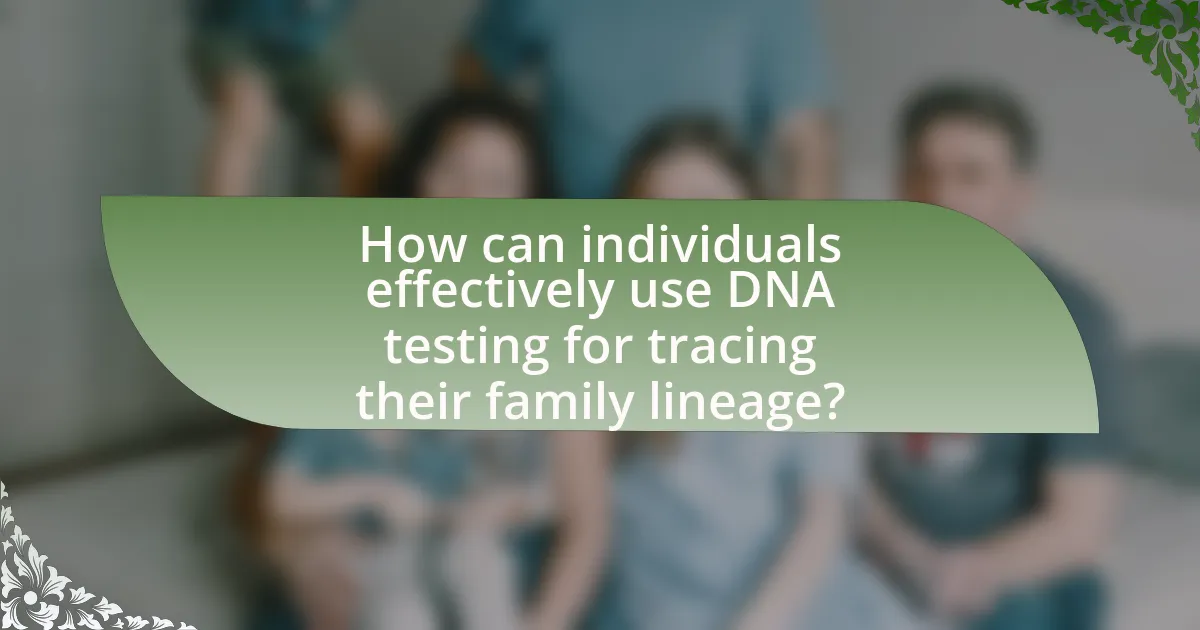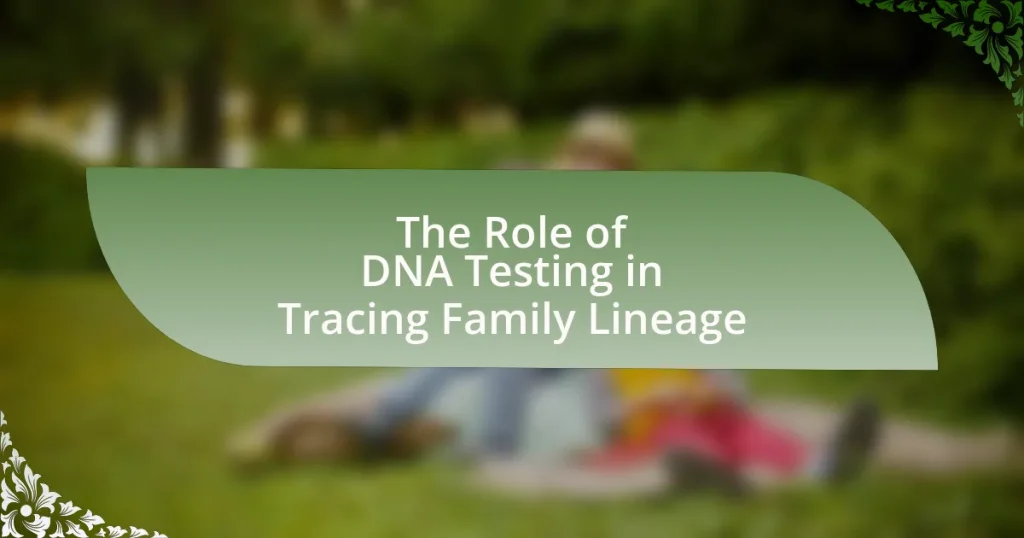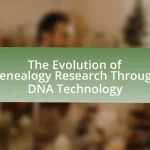DNA testing is a scientific method that plays a vital role in tracing family lineage by providing genetic evidence to confirm or refute familial relationships. The article explores how different types of DNA tests, including Y-DNA, mitochondrial DNA, and autosomal DNA tests, contribute to understanding family history and uncovering ancestral origins. It discusses the growing popularity of DNA testing for genealogy, driven by technological advancements and public interest, while also addressing the limitations and challenges individuals face when interpreting DNA results. Additionally, the article highlights best practices for effectively using DNA testing to enhance genealogical research and resolve family mysteries.
What is the Role of DNA Testing in Tracing Family Lineage?

DNA testing plays a crucial role in tracing family lineage by providing genetic evidence that can confirm or refute familial relationships. This scientific method analyzes specific markers in an individual’s DNA, allowing for comparisons with relatives and potential ancestors. For instance, Y-DNA testing can trace paternal lineage, while mitochondrial DNA testing can trace maternal lineage, revealing connections that may not be documented in historical records. Studies have shown that DNA testing can identify unknown relatives and clarify ancestral origins, enhancing genealogical research accuracy.
How does DNA testing contribute to understanding family history?
DNA testing significantly enhances the understanding of family history by providing genetic evidence that can confirm or refute familial connections. This scientific method allows individuals to trace their ancestry through DNA markers that are inherited from both parents, revealing relationships that may not be documented in traditional records. For instance, studies have shown that DNA testing can uncover previously unknown relatives, identify ethnic backgrounds, and even trace lineage back several generations, offering insights into migration patterns and historical connections.
What types of DNA tests are used for lineage tracing?
The types of DNA tests used for lineage tracing include Y-DNA tests, mitochondrial DNA (mtDNA) tests, and autosomal DNA tests. Y-DNA tests analyze the Y chromosome, which is passed from father to son, making it useful for tracing paternal lineage. Mitochondrial DNA tests examine mtDNA, inherited from the mother, allowing for maternal lineage tracing. Autosomal DNA tests assess the 22 pairs of non-sex chromosomes, providing a broader view of ancestry by identifying genetic connections from both parents and multiple generations. These tests are widely utilized in genealogical research and ancestry services to uncover familial relationships and heritage.
How do different DNA tests provide varying insights into ancestry?
Different DNA tests provide varying insights into ancestry by analyzing distinct types of genetic markers. Autosomal DNA tests examine a person’s entire genome, offering a broad view of ancestry from both maternal and paternal lines, which can reveal ethnic backgrounds and potential relatives. Y-DNA tests focus solely on the paternal lineage by analyzing the Y chromosome, providing insights into direct male ancestry and paternal haplogroups. Mitochondrial DNA tests trace maternal lineage through mitochondrial DNA, which is passed down from mothers to their children, allowing individuals to explore their maternal ancestry. Each test type utilizes specific genetic information, leading to different insights into an individual’s ancestral origins and connections.
Why is DNA testing becoming popular for genealogy?
DNA testing is becoming popular for genealogy because it provides individuals with a scientific method to uncover their ancestral roots and family connections. This popularity is driven by the increasing accessibility of DNA testing services, which allow users to obtain detailed genetic information that can reveal ethnic backgrounds and potential relatives. According to a 2021 report by the Pew Research Center, about 27% of U.S. adults have used a DNA testing service, reflecting a growing interest in personal ancestry exploration. Additionally, advancements in technology have improved the accuracy and affordability of these tests, making them appealing to a broader audience seeking to understand their heritage.
What factors are driving the increase in DNA testing for family lineage?
The increase in DNA testing for family lineage is primarily driven by advancements in technology, affordability, and growing public interest in genealogy. Technological improvements have made DNA sequencing faster and more accurate, while the cost of testing has significantly decreased, making it accessible to a broader audience. Additionally, the rise of social media and online platforms has fostered a community of individuals eager to explore their ancestry, leading to a surge in demand for DNA testing services. According to a report by the Pew Research Center, as of 2021, about 27% of U.S. adults have used a DNA testing service, reflecting a growing trend in personal ancestry exploration.
How has technology influenced the accessibility of DNA testing?
Technology has significantly enhanced the accessibility of DNA testing by reducing costs and simplifying the testing process. Innovations such as at-home testing kits, which can be purchased online for as low as $99, allow individuals to collect samples without needing professional assistance. Furthermore, advancements in sequencing technology, like next-generation sequencing, have increased the speed and accuracy of DNA analysis, making it more widely available to the general public. As a result, millions of people have accessed DNA testing services, with companies like AncestryDNA and 23andMe reporting over 30 million customers combined, demonstrating the widespread adoption and accessibility of these technologies.
What are the key benefits of using DNA testing for family lineage?

DNA testing for family lineage provides accurate identification of biological relationships, enabling individuals to trace their ancestry with precision. This technology utilizes genetic markers to establish familial connections, often revealing previously unknown relatives and ancestral origins. Studies indicate that DNA testing can uncover lineage information that traditional genealogical methods may miss, such as non-paternity events or adoptions. Furthermore, DNA databases can connect individuals to broader family networks, enhancing the understanding of genetic heritage and potential health risks associated with inherited conditions.
How does DNA testing enhance traditional genealogical research?
DNA testing enhances traditional genealogical research by providing concrete biological evidence that can confirm or refute family connections. While traditional methods rely on historical records and documentation, DNA testing offers a scientific approach to tracing lineage through genetic markers. For instance, Y-DNA tests can trace paternal lines, while mitochondrial DNA tests can trace maternal lines, allowing researchers to uncover relationships that may not be documented in historical records. Additionally, DNA databases can connect individuals with unknown relatives, revealing previously hidden family ties and expanding the scope of genealogical research. This integration of genetic data with traditional research methods significantly increases the accuracy and depth of family history investigations.
What unique information can DNA testing reveal that records cannot?
DNA testing can reveal genetic relationships and ancestral origins that traditional records cannot provide. While records may document names, dates, and locations, they often lack information about biological connections, such as half-siblings or unknown parentage. For instance, DNA testing can identify genetic matches with relatives who may not be documented in family trees, uncovering previously unknown family ties. Additionally, it can trace lineage back to specific geographic regions or ethnic groups, offering insights into ancestry that are not available through historical documents alone.
How can DNA testing help in resolving family mysteries?
DNA testing can help resolve family mysteries by providing genetic evidence that clarifies relationships and ancestry. Through techniques such as autosomal DNA testing, individuals can uncover biological connections to relatives, identify unknown family members, and confirm or refute familial claims. For instance, a study published in the journal “Nature” highlights how DNA testing has successfully reunited families separated by adoption or other circumstances, demonstrating its effectiveness in revealing hidden family ties.
What are the limitations of DNA testing in tracing lineage?
DNA testing has limitations in tracing lineage primarily due to the inability to provide a complete ancestral picture. While DNA tests can identify genetic relationships and ancestral origins, they cannot determine the exact lineage or family tree due to factors such as incomplete genealogical records, the complexity of genetic inheritance, and the potential for non-paternity events. For instance, a study published in the American Journal of Human Genetics highlights that while autosomal DNA tests can reveal relatives within a few generations, they may not accurately reflect deeper ancestral connections due to genetic recombination and the dilution of genetic material over generations. Additionally, DNA testing cannot account for cultural, social, or historical contexts that influence lineage, making it a partial tool for understanding family history.
What challenges do individuals face when interpreting DNA results?
Individuals face several challenges when interpreting DNA results, primarily due to the complexity of genetic information and the potential for misinterpretation. The intricate nature of DNA data can lead to confusion regarding ancestry, as individuals may not fully understand how genetic markers correlate with familial connections. Additionally, the presence of unexpected results, such as non-paternity or unknown relatives, can create emotional distress and complicate family narratives. Furthermore, varying interpretations by different testing companies can lead to inconsistent results, making it difficult for individuals to draw accurate conclusions about their lineage. These challenges highlight the need for careful consideration and, often, professional guidance when analyzing DNA results.
How can privacy concerns impact the use of DNA testing?
Privacy concerns can significantly impact the use of DNA testing by deterring individuals from participating in genetic testing services. Many potential users fear that their genetic information may be misused, leading to unauthorized access, discrimination, or breaches of confidentiality. For instance, a survey conducted by the Pew Research Center in 2019 found that 60% of Americans expressed concern about how companies handle their DNA data, indicating a widespread apprehension regarding privacy. This fear can result in lower participation rates in DNA testing, ultimately affecting the accuracy and comprehensiveness of genetic databases used for tracing family lineage.
How can individuals effectively use DNA testing for tracing their family lineage?

Individuals can effectively use DNA testing for tracing their family lineage by selecting a reputable DNA testing service that offers comprehensive ancestry analysis. These services analyze specific markers in an individual’s DNA to provide insights into ethnic backgrounds, geographic origins, and potential relatives. For example, companies like AncestryDNA and 23andMe utilize autosomal DNA testing, which examines inherited DNA from both parents, allowing users to connect with relatives and build family trees based on shared genetic information. Additionally, Y-DNA and mtDNA tests can be used for paternal and maternal lineage tracing, respectively, providing deeper insights into specific ancestral lines. The accuracy of these tests is supported by extensive databases and algorithms that match DNA sequences with those of other users, facilitating connections to distant relatives and historical populations.
What steps should one take before undergoing DNA testing?
Before undergoing DNA testing, individuals should first identify the purpose of the test, whether for ancestry, health insights, or legal reasons. Understanding the specific goals helps in selecting the appropriate type of DNA test, such as autosomal, Y-DNA, or mitochondrial DNA tests, which serve different purposes in tracing lineage. Next, individuals should research and choose a reputable testing company, considering factors like privacy policies, accuracy, and customer reviews. Additionally, it is crucial to consult with family members to gather relevant information and discuss potential implications of the results, as DNA testing can reveal unexpected relationships or health risks. Finally, individuals should prepare for the testing process by following the sample collection instructions provided by the testing company to ensure valid results.
How can individuals prepare for the potential outcomes of DNA testing?
Individuals can prepare for the potential outcomes of DNA testing by educating themselves about the implications of the results and considering emotional support options. Understanding that DNA testing can reveal unexpected information, such as unknown relatives or health risks, is crucial for managing expectations. Research indicates that many individuals experience a range of emotions upon receiving their results, including shock or confusion, which underscores the importance of having a support system in place, such as family, friends, or professional counselors. Additionally, reviewing the privacy policies of testing companies and considering the potential for data sharing can help individuals make informed decisions about their participation in DNA testing.
What resources are available to help interpret DNA results?
Resources available to help interpret DNA results include genetic counseling services, online platforms like 23andMe and AncestryDNA, and academic publications on genetic genealogy. Genetic counselors provide personalized insights and explanations regarding DNA test results, helping individuals understand their genetic information in the context of family lineage. Online platforms often offer tools and resources for interpreting results, including ethnicity estimates and potential relatives based on shared DNA. Academic publications, such as “Genetic Genealogy in Practice” by Blaine Bettinger and Debbie Parker Wayne, provide in-depth knowledge and methodologies for analyzing DNA results in genealogical research.
What best practices should be followed when using DNA testing for genealogy?
When using DNA testing for genealogy, best practices include selecting a reputable testing company, understanding the types of tests available, and being aware of privacy implications. Choosing a reputable company ensures accurate results; for instance, companies like AncestryDNA and 23andMe are well-regarded for their extensive databases and reliable methodologies. Understanding the types of tests—such as autosomal, Y-DNA, and mitochondrial DNA tests—helps individuals select the most appropriate option for their genealogical goals. Additionally, being aware of privacy implications is crucial, as sharing genetic data can have long-term consequences; thus, reviewing the company’s privacy policy is essential. These practices enhance the reliability and effectiveness of DNA testing in tracing family lineage.
How can individuals ensure they are using reputable DNA testing services?
Individuals can ensure they are using reputable DNA testing services by researching the company’s accreditation and reviews. Reputable services are often accredited by organizations such as the American Association of Blood Banks or the College of American Pathologists, which indicates adherence to industry standards. Additionally, checking customer reviews and testimonials on independent platforms can provide insights into the reliability and accuracy of the service. Furthermore, individuals should verify that the company has transparent privacy policies regarding data handling and storage, as well as clear communication about the testing process and results.
What strategies can enhance the accuracy of lineage tracing through DNA?
Strategies that can enhance the accuracy of lineage tracing through DNA include using high-resolution genomic sequencing, employing advanced bioinformatics tools, and integrating genealogical data with genetic information. High-resolution genomic sequencing allows for the detection of more genetic variants, which improves the resolution of lineage connections. Advanced bioinformatics tools facilitate the analysis of complex genetic data, enabling researchers to identify relationships and ancestry with greater precision. Additionally, integrating genealogical data, such as historical records and family trees, with genetic information provides context that can clarify lineage connections and reduce ambiguity in results. These strategies collectively contribute to more accurate and reliable lineage tracing outcomes.
What common misconceptions exist about DNA testing in genealogy?
Common misconceptions about DNA testing in genealogy include the belief that DNA tests can provide a complete family history and that they can definitively identify specific ancestors. In reality, DNA tests offer insights into genetic ancestry and can indicate potential relatives, but they do not trace lineage in a linear fashion or guarantee identification of individual ancestors. Additionally, many people mistakenly think that DNA testing can reveal detailed ethnic backgrounds; however, results are often based on reference populations and can vary significantly between testing companies.
How can understanding these misconceptions improve the testing experience?
Understanding misconceptions about DNA testing can significantly enhance the testing experience by fostering informed decision-making and realistic expectations. When individuals grasp common myths, such as the belief that DNA tests can provide complete family histories or that they are infallible, they are more likely to approach the results with a critical mindset. This understanding can lead to better engagement with the testing process, as individuals will seek clarification on results and implications rather than accepting them at face value. Research indicates that informed consumers are more satisfied with their testing outcomes, as they can contextualize findings within the broader scope of their family history.
What should individuals know about the limitations of DNA ancestry claims?
Individuals should know that DNA ancestry claims have limitations in accuracy and interpretation. These limitations arise from the fact that DNA tests primarily provide information about genetic markers and can only estimate ancestral origins based on reference populations, which may not represent the full diversity of an individual’s ancestry. Furthermore, the results can be influenced by the algorithms used by testing companies, leading to varying interpretations of the same genetic data. For example, a study published in the journal “Nature” highlighted that different companies can yield significantly different ancestry estimates for the same individual due to differences in their reference databases and methodologies. Additionally, DNA tests cannot account for non-genetic factors such as cultural heritage or family history, which are essential for a comprehensive understanding of one’s lineage.




